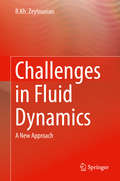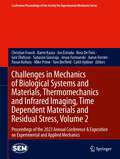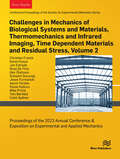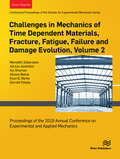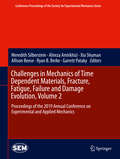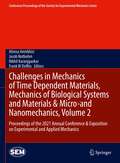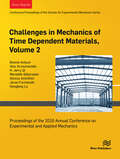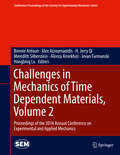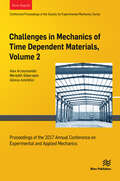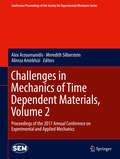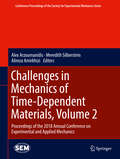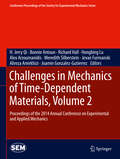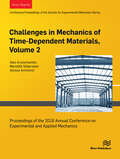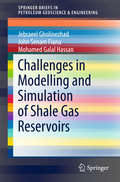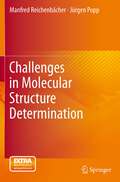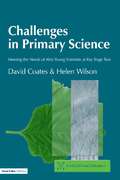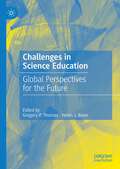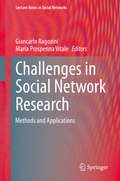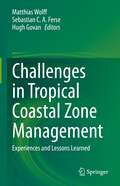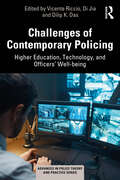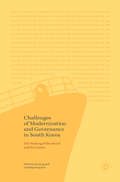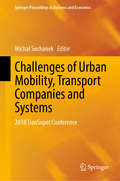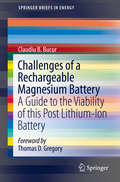- Table View
- List View
Challenges in Characterizing Small Particles
by National Research Council Chemical Sciences Roundtable Division on Earth and Life Studies Joe Alper Tina Masciangioli Board on Chemical Sciences and TechnologySmall particles are ubiquitous in the natural and built worlds and have tremendous impact throughout. However, a lack of understanding about the properties and chemical composition of small particles limits our ability to predict, and control their applications and impacts. Challenges in Characterizing Small Particles: Exploring Particles from the Nano- to Microscales summarizes presentations and discussions at a 2010 National Academies roundtable. Speakers at this roundtable discussed the crucial types of information that need to be determined about small particles in different media. They also explored the critical importance of small particles in environmental science, materials and chemical sciences, biological science, and engineering, and the many challenges involved in characterizing materials at the nano- and microscales. The discussions on characterization included static, dynamic, experimental, computational, and theoretical characterization. The workshop also included several "research tool" presentations that highlighted new advances in characterizing small particles.
Challenges in Chemistry Graduate Education
by National Research Council Division on Earth and Life Studies Board on Chemical Sciences and Technology Committee on Challenges in Chemistry Graduate Education; Board on Chemical SciencesChemistry graduate education is under considerable pressure. Pharmaceutical companies, long a major employer of synthetic organic chemists, are drastically paring back their research divisions to reduce costs. Chemical companies are opening new research and development facilities in Asia rather than in the United States to take advantage of growing markets and trained workforces there. Universities, especially public universities, are under significant fiscal constraints that threaten their ability to hire new faculty members. Future federal funding of chemical research may be limited as the federal budget tightens. All of these trends have major consequences for the education of chemistry graduate students in U.S. universities. To explore and respond to these intensifying pressures, the Board on Chemical Sciences and Technology held a workshop in Washington, DC, on January 23-24 2012, titled "Graduate Education in Chemistry in the Context of a Changing Environment." The workshop brought together representatives from across the chemical enterprise, representing leaders and future leaders of academia, industry, and government. The goal of the workshop was not to come to conclusions, but to have an open and frank discussion about critical issues affecting chemistry graduate education, such as the attraction and retainment of the most able students to graduate education, financial stressors on the current support model and their implications for the future model, competencies needed in the changing job market for Ph.D. chemists, and competencies needed to address societal problems such as energy and sustainability. Challenges in Chemistry Graduate Education: A Workshop Summary is organized into six chapters and summarizes the workshop on "Graduate Education in Chemistry in the Context of a Changing Environment."
Challenges in Fluid Dynamics: A New Approach
by R. Kh. ZeytounianThis monograph presents a synopsis of fluid dynamics based on the personal scientific experience of the author who has contributed immensely to the field. The interested reader will also benefit from the general historical context in which the material is presented in the book. The book covers a wide range of relevant topics of the field, and the main tool being rational asymptotic modelling (RAM) approach. The target audience primarily comprises experts in the field of fluid dynamics, but the book may also be beneficial for graduate students.
Challenges in Mechanics of Biological Systems and Materials, Thermomechanics and Infrared Imaging, Time Dependent Materials and Residual Stress, Volume 2: Proceedings of the 2023 Annual Conference & Exposition on Experimental and Applied Mechanics (Conference Proceedings of the Society for Experimental Mechanics Series)
by Jevan Furmanski Christian Franck Karen Kasza Aaron Forster Jon Estrada Tom Berfield Suhasini Gururaja Rosa De Finis Geir Ólafsson Pavan Kolluru Mike Prime Cahit AydinerChallenges in Mechanics of Biological Systems and Materials, Thermomechanics and Infrared Imaging, Time Dependent Materials and Residual Stress, Volume 2 of the Proceedings of the 2023 SEM Annual Conference & Exposition on Experimental and Applied Mechanics, the second volume of five from the Conference, brings together contributions to this important area of research and engineering. The collection presents early findings and case studies on fundamental and applied aspects of Experimental Mechanics, including papers in the following general technical research areas: Advanced Thermographic Techniques for SHM AM Composites and Polymers Experimental Techniques in Biomechanics and Mechanobiology Inverse Methodologies and Uncertainties in the Identification of Residual Stresses, Residual Stress IV Low Cost Thermographic Applications Multiscale Mechanics of Biological Materials NDE and Process Monitoring Residual Stress ThermomechanicsTime Dependence in Porous and Soft Materials
Challenges in Mechanics of Biological Systems and Materials, Thermomechanics and Infrared Imaging, Time Dependent Materials and Residual Stress, Volume 2: Proceedings of the 2023 Annual Conference on Experimental and Applied Mechanics
by Jevan Furmanski Christian Franck Karen Kasza Aaron Forster Jon Estrada Tom Berfield Suhasini Gururaja Rosa De Finis Geir Ólafsson Pavan Kolluru Mike Prime Cahit AydinerChallenges in Mechanics of Biological Systems and Materials, Thermomechanics and Infrared Imaging, Time Dependent Materials and Residual Stress, Volume 2 of the Proceedings of the 2023 SEM Annual Conference & Exposition on Experimental and Applied Mechanics, the second volume of five from the Conference, brings together contributions to this important area of research and engineering. The collection presents early findings and case studies on fundamental and applied aspects of Experimental Mechanics, including papers in the following general technical research areas: Advanced Thermographic Techniques for SHM AM Composites and Polymers Experimental Techniques in Biomechanics and Mechanobiology Inverse Methodologies and Uncertainties in the Identification of Residual Stresses, Residual Stress IV Low Cost Thermographic Applications Multiscale Mechanics of Biological Materials NDE and Process Monitoring Residual Stress Thermomechanics Time Dependence in Porous and Soft Materials.
Challenges in Mechanics of Time Dependent Materials, Fracture, Fatigue, Failure and Damage Evolution, Volume 2: Proceedings of the 2019 Annual Conference on Experimental and Applied Mechanics
by Alireza Amirkhizi Meredith Silberstein Garrett Pataky Xia Shuman Allison Berke Ryan B. BeeseChallenges in Mechanics of Time-Dependent Materials, Volume 2 of the Proceedings of the 2019 SEM Annual Conference & Exposition on Experimental and Applied Mechanics, the second volume of six from the Conference, brings together contributions to this important area of research and engineering. The collection presents early findings and case studies on fundamental and applied aspects of Experimental Mechanics, including papers in the following general technical research areas: Characterization Across Length Scales Extreme Conditions & Environmental Effects Soft Materials and Biomaterials Damage, Fatigue and Fracture Structure, Function and Performance Rate Effects in Elastomers Viscoelasticity & Viscoplasticity Research in Progress In-situ Techniques and Microscale Effects on Mechanical Behavior Fracture and Fatigue in Brittle Materials Novel Experimental Method Fatigue and Fracture in Extreme Environments Integration of Models and Experiments Failure in Elastomers and Gels Rate Effects in Elastomers Microscale and Microstructural Effects on Mechanical Behavior Mechanics of Energy Materials Additive Manufacturing: Fatigue and Fracture Mechanics of Composite Materials Interfacial and Mixed-Mode Fracture Vibration Effects and High Cycle Fatigue.
Challenges in Mechanics of Time Dependent Materials, Fracture, Fatigue, Failure and Damage Evolution, Volume 2: Proceedings of the 2019 Annual Conference on Experimental and Applied Mechanics (Conference Proceedings of the Society for Experimental Mechanics Series)
by Alireza Amirkhizi Meredith Silberstein Ryan B. Berke Garrett Pataky Xia Shuman Allison BeeseChallenges in Mechanics of Time-Dependent Materials, Volume 2 of the Proceedings of the 2019 SEM Annual Conference& Exposition on Experimental and Applied Mechanics, the second volume of six from the Conference, brings together contributions to this important area of research and engineering. The collection presents early findings and case studies on fundamental and applied aspects of Experimental Mechanics, including papers in the following general technical research areas: Characterization Across Length Scales Extreme Conditions & Environmental Effects Soft Materials and Biomaterials Damage, Fatigue and Fracture Structure, Function and Performance Rate Effects in Elastomers Viscoelasticity & Viscoplasticity Research in Progress In-situ Techniques and Microscale Effects on Mechanical Behavior Fracture and Fatigue in Brittle Materials Novel Experimental Methods Fatigue and Fracture in Extreme Environments Integration of Models and Experiments Failure in Elastomers and Gels Rate Effects in Elastomers Microscale and Microstructural Effects on Mechanical Behavior Mechanics of Energy Materials Additive Manufacturing: Fatigue and Fracture Mechanics of Composite Materials Interfacial and Mixed-Mode Fracture Vibration Effects and High Cycle Fatigue
Challenges in Mechanics of Time Dependent Materials, Mechanics of Biological Systems and Materials & Micro-and Nanomechanics, Volume 2: Proceedings of the 2021 Annual Conference & Exposition on Experimental and Applied Mechanics (Conference Proceedings of the Society for Experimental Mechanics Series)
by Alireza Amirkhizi Nikhil Karanjgaokar Jacob Notbohm Frank W DelRioChallenges in Mechanics of Time-Dependent Materials, Mechanics of Biological Systems and Materials, and Micro-and Nanomechanics, Volume 2 of the Proceedings of the 2021 SEM Annual Conference & Exposition on Experimental and Applied Mechanics, the second volume of four from the Conference, brings together contributions to this important area of research and engineering. The collection presents early findings and case studies on fundamental and applied aspects of Experimental Mechanics, including papers in the following general technical research areas: Characterization Across Length Scales Extreme Conditions & Environmental Effects Damage, Fatigue and Fracture Structure, Function and Performance Rate Effects in Elastomers Viscoelasticity & Viscoplasticity Research in Progress Extreme Nanomechanics In-Situ Nanomechanics Expanding Boundaries in Metrology Micro and Nanoscale Deformation MEMS for Actuation, Sensing and Characterization 1D & 2D Materials Cardiac Mechanics Cell Mechanics Biofilms and Microbe Mechanics Traumatic Brain Injury Orthopedic Biomechanics Ligaments and Soft Materials
Challenges in Mechanics of Time Dependent Materials, Volume 2: Proceedings of the 2016 Annual Conference on Experimental and Applied Mechanics
by Anders Brandt Raj SinghalChallenges in Mechanics of Time-Dependent Materials, Volume 2 of the Proceedings of the 2016 SEM Annual Conference & Exposition on Experimental and Applied Mechanics, the second volume of ten from the Conference, brings together contributions to this important area of research and engineering. The collection presents early findings and case studies on fundamental and applied aspects of Experimental Mechanics, including papers in the following general technical research areas: Extreme Environments & Environmental Effects Structure-Function of Performance of PE Effects of Inhomogeneities & Interfaces Characterization Across Scales Mechanics of Energy & Energetic Materials Metallic Materials Viscoelasticity & Viscoplasticity.
Challenges in Mechanics of Time Dependent Materials, Volume 2: Proceedings of the 2016 Annual Conference on Experimental and Applied Mechanics (Conference Proceedings of the Society for Experimental Mechanics Series #37)
by Bonnie Antoun Hongbing Lu H. Jerry Qi Alireza Amirkhizi Jevan Furmanski Alex Arzoumanidis Meredith SilbersteinChallenges in Mechanics of Time-Dependent Materials, Volume 2 of the Proceedings of the 2016 SEM Annual Conference& Exposition on Experimental and Applied Mechanics, the second volume of ten from the Conference, brings together contributions to this important area of research and engineering. The collection presents early findings and case studies on fundamental and applied aspects of Experimental Mechanics, including papers in the following general technical research areas: Extreme Environments & Environmental Effects Structure-Function of Performance of PE Effects of Inhomogeneities & Interfaces Characterization Across Scales Mechanics of Energy & Energetic Materials Metallic Materials Viscoelasticity & Viscoplasticity
Challenges in Mechanics of Time Dependent Materials, Volume 2: Proceedings of the 2017 Annual Conference on Experimental and Applied Mechanics
by Alireza Amirkhizi Alex Arzoumanidis Meredith SilbersteinChallenges in Mechanics of Time-Dependent Materials, Volume 2 of the Proceedings of the 2017 SEM Annual Conference & Exposition on Experimental and Applied Mechanics, the second volume of nine from the Conference, brings together contributions to this important area of research and engineering. The collection presents early findings and case studies on fundamental and applied aspects of Experimental Mechanics, including papers in the following general technical research areas: Characterization Across Length Scales Extreme Environments & Environmental Effects Viscoelasticity Structure Function Performance Polymer Viscoplasticity Metallic Materials Fracture/Fatigue/Damage Composites Soft Materials
Challenges in Mechanics of Time Dependent Materials, Volume 2: Proceedings of the 2017 Annual Conference on Experimental and Applied Mechanics (Conference Proceedings of the Society for Experimental Mechanics Series)
by Alireza Amirkhizi Alex Arzoumanidis Meredith SilbersteinChallenges in Mechanics of Time-Dependent Materials, Volume 2 of the Proceedings of the 2016 SEM Annual Conference& Exposition on Experimental and Applied Mechanics, the second volume of ten from the Conference, brings together contributions to this important area of research and engineering. The collection presents early findings and case studies on fundamental and applied aspects of Experimental Mechanics, including papers in the following general technical research areas: Extreme Environments & Environmental Effects Structure-Function of Performance of PE Effects of Inhomogeneities & Interfaces Characterization Across Scales Mechanics of Energy & Energetic Materials Metallic Materials Viscoelasticity & Viscoplasticity
Challenges in Mechanics of Time-Dependent Materials, Volume 2: Proceedings Of The 2014 Annual Conference On Experimental And Applied Mechanics (Conference Proceedings of the Society for Experimental Mechanics Series)
by Alireza Amirkhizi Alex Arzoumanidis Meredith SilbersteinChallenges in Mechanics of Time-Dependent Materials, Volume 2 of the Proceedings of the 2018 SEM Annual Conference& Exposition on Experimental and Applied Mechanics, the second volume of eight from the Conference, brings together contributions to this important area of research and engineering. The collection presents early findings and case studies on fundamental and applied aspects of Experimental Mechanics, including papers in the following general technical research areas: Characterization Across Length Scales Extreme Environments & Environmental Effects Soft Materials Damage, fatigue and Fracture Inhomogeneities & Interfaces Viscoelasticity Research in Progress
Challenges in Mechanics of Time-Dependent Materials, Volume 2: Proceedings of the 2014 Annual Conference on Experimental and Applied Mechanics (Conference Proceedings of the Society for Experimental Mechanics Series #37)
by Richard Hall Bonnie Antoun Hongbing Lu H. Jerry Qi Alireza Amirkhizi Jevan Furmanski Alex Arzoumanidis Meredith Silberstein Joamin Gonzalez-GutierrezChallenges in Mechanics of Time-Dependent Materials, Volume 2: Proceedings of the 2014 Annual Conference on Experimental and Applied Mechanics, the second volume of eight from the Conference, brings together contributions to this important area of research and engineering The collection presents early findings and case studies on fundamental and applied aspects of Experimental Mechanics, including papers in the following general technical research areas: Metallic, Polymeric and Composite Materials o Effects of Extreme Environments including Radiation Resistance, Damage, and Aging o Challenges in Time-dependent Behavior Modeling of Low, Moderate and High Strain Rates o Effects of Inhomogeneities on the Time-Dependent Behavior o Time dependent granular materials · Composite, Hybrid and Multifunctional Materials o Challenges in Time-dependent Behavior Modeling Viscoelastoplasticity and Damage o Effects of Interfaces and Interphases on the Time-Dependent Behavior · Mechanics of materials from advanced manufacturing, such as additive manufacturing o Property characterization from AM o Process modeling and simulations of AM o Material design using AM · Time-dependent and Small-scale Effects in Micro/Nano-scale Testing
Challenges in Mechanics of Time-Dependent Materials, Volume 2: Proceedings of the 2018 Annual Conference on Experimental and Applied Mechanics
by Alireza Amirkhizi Alex Arzoumanidis Meredith SilbersteinChallenges in Mechanics of Time-Dependent Materials, Volume 2 of the Proceedings of the 2018 SEM Annual Conference& Exposition on Experimental and Applied Mechanics, the second volume of eight from the Conference, brings together contributions to this important area of research and engineering. The collection presents early findings and case studies on fundamental and applied aspects of Experimental Mechanics, including papers in the following general technical research areas: Characterization Across Length Scales Extreme Environments & Environmental Effects Soft Materials Damage, fatigue and Fracture Inhomogeneities & Interfaces Viscoelasticity Research in Progress.
Challenges in Modelling and Simulation of Shale Gas Reservoirs (Springerbriefs In Petroleum Geoscience And Engineering Ser.)
by Jebraeel Gholinezhad John Senam Fianu Mohamed Galal HassanThis book addresses the problems involved in the modelling and simulation of shale gas reservoirs, and details recent advances in the field. It discusses various modelling and simulation challenges, such as the complexity of fracture networks, adsorption phenomena, non-Darcy flow, and natural fracture networks, presenting the latest findings in these areas. It also discusses the difficulties of developing shale gas models, and compares analytical modelling and numerical simulations of shale gas reservoirs with those of conventional reservoirs. Offering a comprehensive review of the state-of-the-art in developing shale gas models and simulators in the upstream oil industry, it allows readers to gain a better understanding of these reservoirs and encourages more systematic research on efficient exploitation of shale gas plays. It is a valuable resource for researchers interested in the modelling of unconventional reservoirs and graduate students studying reservoir engineering. It is also of interest to practising reservoir and production engineers.
Challenges in Molecular Structure Determination
by Jürgen Popp Manfred ReichenbächerTaking a problem-based approach, the authors provide a practice-oriented and systematic introduction to both organic and inorganic structure determination by spectroscopic methods. This includes mass spectrometry, vibrational spectroscopies, UV/VIS spectroscopy and NMR as well as applying combinations of these methods. The authors show how to elucidate chemical structures with a minimal number of spectroscopic techniques. Readers can train their skills by more than 400 problems with varying degree of sophistication. Interactive Powerpoint-Charts are available as Extra Materials to support self-study.
Challenges in Primary Science: Meeting the Needs of Able Young Scientists at Key Stage Two (A\nace/fulton Publication Ser.)
by David Coates Helen WilsonThis practical and easy-to-use book enables teachers to challenge able children to develop their potential and to extend their thinking in primary science. It links theory to practice to develop understanding of what it means to be an able scientist; and empowers teachers to build on their existing good practice to build an inclusive science curriculum for able children. Special features include: photocopiable resources that are linked to the National Curriculum and the QCA schemes of work; teacher guidance on the use of these resources and how they can be incorporated into normal primary science lessons; and suggestions for assessment.
Challenges in Science Education: Global Perspectives for the Future
by Helen J. Boon Gregory P. ThomasThis edited volume focuses on challenges facing science education across three areas: curriculum, teacher education, and pedagogy. Integrating a diverse range of perspectives from both emerging and established scholars in the field, chapters consider the need for measured responses to issues in society that have become pronounced in recent years, including lessons from the Covid-19 pandemic, the environment, and persisting challenges in STEM teaching and learning. In doing so, the editors and their authors chart a potential course for existing and future possibilities and probabilities for science education.
Challenges in Social Network Research: Methods and Applications (Lecture Notes in Social Networks)
by Giancarlo Ragozini Maria Prosperina VitaleThe book includes both invited and contributed chapters dealing with advanced methods and theoretical development for the analysis of social networks and applications in numerous disciplines. Some authors explore new trends related to network measures, multilevel networks and clustering on networks, while other contributions deepen the relationship among statistical methods for data mining and social network analysis. Along with the new methodological developments, the book offers interesting applications to a wide set of fields, ranging from the organizational and economic studies, collaboration and innovation, to the less usual field of poetry. In addition, the case studies are related to local context, showing how the substantive reasoning is fundamental in social network analysis. The list of authors includes both top scholars in the field of social networks and promising young researchers. All chapters passed a double blind review process followed by the guest editors. This edited volume will appeal to students, researchers and professionals.
Challenges in Tropical Coastal Zone Management: Experiences and Lessons Learned
by Matthias Wolff Sebastian C. A. Ferse Hugh GovanThis book focuses on tropical coasts, which are highly vulnerable due to a multitude of stressors. Population growth is substantial, habitats are lost and biodiversity is reduced at an alarming rate, severely affecting many ecosystem services. This situation calls for sound coastal management and the effective engagement of all relevant stakeholders. About two decades ago the M.Sc. program ISATEC (International Studies in Aquatic Tropical Ecology) was created at Bremen University (Germany) to train young scientists for a professional engagement in the complex field of tropical coastal and resource management. This book provides a platform for those Alumni to report on their work experiences and findings in their home countries and covers all regions of the tropical belt. Part I of the book provides a short review of the state of the tropical ocean and its resources and of international attempts towards sustainable ocean management starting with the Rio Declaration on Environment and Development in 1992. Part II deals with country case studies, and part III focuses on an evaluation & synopsis of those contributions. Emerging key issues for management and conservation of the tropical coastal environments are presented and critical challenges on the path towards reaching the Sustainable Development Goals (SDGs) are discussed, as are the needs for enhancing research and capacity development.
Challenges of Contemporary Policing: Higher Education, Technology, and Officers’ Well-Being (Advances in Police Theory and Practice)
by Vicente RiccioThis edited collection reflects contemporary challenges faced by police forces across the globe and the role of technology in addressing them. The use of science and technology raises questions about ethics, training, the well-being of people, and freedom. New technologies promise to foster police practices based on intelligence, accuracy, and preparedness, and are considered necessary to overcome challenges such as declining budgets, lack of personnel, and legitimacy. However, technologies can also be used for authoritarian and nefarious purposes. For those reasons, this book aims to discuss related topics from various contexts to establish connections among common problems in the field of policing across the globe. This book provides an internationally relevant assessment of the use of technology in the field of policing, as well as the impact on training and police well-being. It is ideal for an academic audience at both graduate and undergraduate levels in the fields of criminal justice studies, police studies, legal sociology, and public policy, and will be of interest to police practitioners, legal professionals, social service workers, and public-sector managers.
Challenges of Modernization and Governance in South Korea
by Jae-Jung Suh Mikyoung KimFocusing on the sinking of the Sewol, a commercial ferry which capsized off the South Korean coast in April 2014, this book considers key issues of disaster, governance, civil society and the ideational transformation of human agents and their empowerment. Providing a lens through which to re-examine South Korean institutions, laws and practices, the volume examines the impact of the Sewol incident and what it reveals about the fault lines of South Korean society and governance. It addresses the repercussions of South Korea’s turn to a liberal democracy and neoliberal economy and reflects on the multilayered implications of the disaster in respect to the potential human costs of the country’s state-driven development policy and high stress modernisation. The book also highlights the relevance of the Korean experience for other societies on a similar developmental trajectories and facing similar challenges.
Challenges of Urban Mobility, Transport Companies and Systems: 2018 TranSopot Conference (Springer Proceedings in Business and Economics)
by Michał SuchanekThis proceedings volume examines individual city transports, transport companies and entire transport systems. Featuring select contributions presented at the 2018 TranSopot Conference in Sopot, Poland, this book provides an analysis of transportation solutions both at the micro-level (single city or single company) as well as the macro-level (whole transportation systems). The enclosed research and case studies provide a theoretical background for transport analysis but also new innovative and sustainable solutions to transportation while also increasing the efficiency of transport operations. Transportation is a very specific area of social and economic life. It creates countless opportunities and fulfills the need for mobility while also generating significant cost—direct for the company or indirect to societies. Planning and organizing transport is a task which requires a multi-level approach with a focus on operational, ecological and financial aspects. At a time in which many transport systems are unable to grow extensively due to lack of space or increased cost, these activities are even more crucial. The enclosed research from researchers, scholars and practitioners provides not only new theories but also empirical data and practical experience. The TranSopot 2018 conference is a continuation of a long series of conferences devoted to the topic of transport sector development. The goal of the conference is to exchange current trends and spread the results of current research into the fields of transport growth, development and management.
Challenges of a Rechargeable Magnesium Battery: A Guide to the Viability of this Post Lithium-Ion Battery (SpringerBriefs in Energy)
by Claudiu B. BucurThis expert volume addresses the practical challenges which have so far inhibited the commercial realization of a rechargeable magnesium battery, placing the discussion within the context of the already established lithium-ion battery. Lithium-ion batteries are becoming commonplace in most power applications, starting with portable electronics and expanding to motor vehicles, stationary storage, and backup power. Since their introduction 25 years ago, they have slowly been replacing all other battery chemistries. As the technology has matured, it is nearing its theoretical limits in terms of energy density, so research and development worldwide is quickly shifting towards the study of new battery chemistries with cheaper components and higher energy densities. A very popular battery candidate which has generated a lot of recent interest is the magnesium rechargeable battery. Magnesium is five orders of magnitude more abundant than lithium, can move two electron s per cation, and is known to plate smoothly without any evidence of dendritic growth. However, many challenges remain to be overcome. This essential volume presents an unfiltered view on both the realistic promises and significant obstacles for this technology, providing key insights and proposed solutions.


